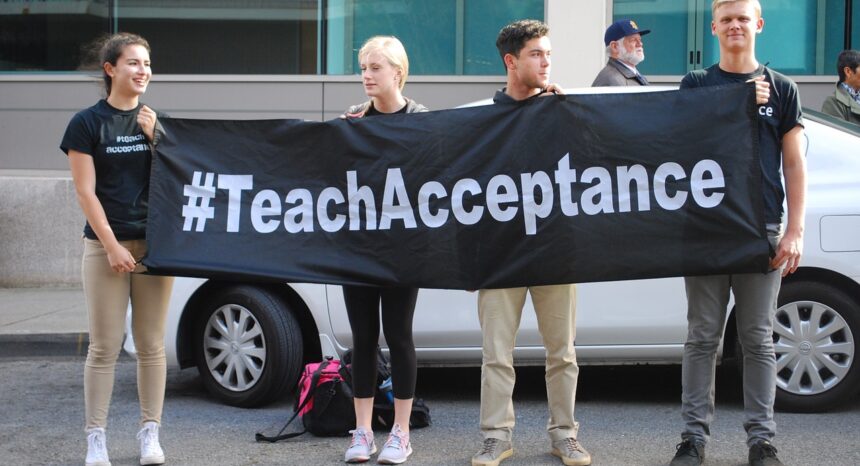Research has shown that sexual-minority youth — those who identify as lesbian, gay, bisexual or transgender — are more likely than their heterosexual peers to experience violence in their lives, including bullying, harassment and physical assault. In addition to the safety and physical health consequences, violence and victimization are associated with higher rates of anxiety, depression and suicide, and indeed, sexual minorities have been found to bear a disproportionate burden with respect to these health issues. A 2011 meta-analysis in the Journal of Adolescent Health found that young people who identify as LGBT are nearly three times more likely to commit suicide than heterosexual youth.
A 2006 study in the Journal of Clinical Child and Adolescent Psychology found that the degree to which adolescents feel accepted and welcomed in their schools significantly predicts overall mental health as well as symptoms of depression and anxiety. A positive school climate is defined by the U.S. Department of Education as “the extent to which a school community creates and maintains a safe school campus, a supportive academic, disciplinary and physical environment, and respectful, trusting and caring relationships throughout the school community.” Research from New York University on the impact of school climate on LGBT youth found that victimization experiences were associated with decreased self-esteem, poorer grades and higher absenteeism rates.
A 2014 study published in the American Journal of Public Health, “Protective School Climates and Reduced Risk for Suicide Ideation in Sexual Minority Youths,” analyzed data on sexual orientation and suicide-related behavior from the 2006 and 2007 Youth Risk Behavior Surveillance Survey, and state and city-level data from the 2010 School Health Profile Survey. Supportive school climates were characterized in part by: the presence of Gay-Straight Alliances; educational curriculum on LGBT-relevant topic areas; policies prohibiting harassment; the encouragement of staff to attend relevant trainings; and the connection of sexual-minority youth to LGBT-friendly, off-campus health providers.
The study’s authors are Mark L. Hatzenbuehler of Mailman School of Public Health at Columbia University; Michelle Birkett of the Feinberg School of Medicine at Northwestern University; Aimee Van Wagenen at the Fenway Institute; and Ilan H. Meyer of the Williams Institute at the UCLA School of Law.
The study’s findings include:
- Of the 55,599 students in the analysis, 1.3% identified as lesbian or gay, 3.5% as bisexual and 2.4% as unsure.
- Sexual-minority youth faced a greater risk of contemplating suicide, making a plan and attempting suicide compared to heterosexual youth, with bisexual adolescents experiencing the greatest risk with respect to all three outcomes. Among all youth studied, 13% reported experiencing suicidal thoughts, 11% reported making a plan to commit suicide and 8% reported a history of attempting suicide.
- School climate played a significant role in past-year suicidal ideation: Lesbian and gay youth in positive school climates experienced a 70% lower probability of suicidal ideation compared to those in states or cities with less-inclusive school climates, while bisexual youth had a 80% lower probability. The results were found to be statisitically significant even after controlling for potentially confounding factors.
“The findings point to potential targets for public health interventions aimed at reducing sexual orientation disparities in suicide risk,” the researchers conclude. “In particular, comprehensive suicide prevention and interventions for sexual-minority adolescents should address not only individual-level and family-level factors but also broader social-contextual influences, including school climate.”
Related research
The February 2014 issue of the American Journal of Public Health includes a number of noteworthy studies related to the mental health of sexual-minority youth. They are:
“Indicators of Victimization and Sexual Orientation Among Adolescents: Analyses From Youth Risk Behavior Surveys”
S.T. Russell, B.G. Everett, M. Rosario, M. Birkitt. American Journal of Public Health. February 2014, 104:255-261. doi: 10.2105/AJPH.2013.301493.
Key finding: “Sexual minority youths reported more fighting than heterosexual youths, especially at younger ages, and more nonphysical school victimization that persisted through adolescence.”
“Sexual Orientation and Suicide Ideation, Plans, Attempts and Medically Serious Attempts: Evidence From Local Youth Risk Behavior Surveys, 2001-2009”
D.M. Stone, F. Luo, L. Ouyang, C. Lippy, M.F. Hertz, A.E. Crosby. American Journal of Public Health, February 2014, 104:262-271. doi: 10.2105/AJPH.2013.301383.
Key finding: “Sexual-minority youth had increased odds of suicide ideation; bisexual youths, gay males and both-sex contact females had greater odds of suicide planning; all sexual-minority youth, except same-sex contact males, had increased odds of suicide attempts; and lesbians, bisexuals and both-sex contact youths had increased odds of medically serious attempts.”
“Lesbian, Gay, Bisexual and Transgender Hate Crimes and Suicidality Among a Population-Based Sample of Sexual-Minority Adolescents in Boston”
D.T. Duncan, M.L. Hatzenbuehler. American Journal of Public Health. February 2014, 104:272-278. doi: 10.2105/AJPH.2013.301424.
Key finding: “Sexual-minority youths residing in neighborhoods with higher rates of LGBT assault hate crimes were significantly more likely to report suicidal ideation (P = 0.013) and suicide attempts (P = 0.006), than were those residing in neighborhoods with lower LGBT assault hate crime rates.”
Keywords: lesbian, gay, transsexual, bisexual, transgender, gay issues, research roundup


Expert Commentary